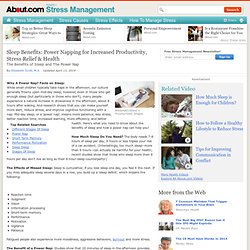

Emotional Skills Toolkit: Bring Your Life Into Balance. We often hear from people who feel overwhelmed by stress, family, work and relationship problems, health challenges, and painful emotions.

They’ve tried many approaches to help themselves feel better, but they just can’t seem to follow through, or what they’ve done hasn't helped them enough. If this sounds familiar, you know that it’s all too easy to become discouraged when you’re stuck. The problem is not willpower—all the willpower in the world won’t matter if you can’t manage stress or keep your emotions in balance. The good news: you can learn these important emotional skills, no matter your age or the obstacles you face.
That’s what this free online program teaches. Skill building, like any learning, takes time and effort. Alternate Sleep Cycles. Most people only think that there is one way to sleep: Go to sleep at night for 6-8 hours, wake up in the morning, stay awake for 16-18 hours and then repeat.

Actually, that is called a monophasic sleep cycle, which is only 1 of 5 major sleep cycles that have been used successfully throughout history. The other 4 are considered polyphasic sleep cycles due to the multiple number of naps they require each day. How is this possible? How is this healthy? Well the most important of every sleep cycle is the Stage 4 REM (Rapid Eye Movement) sleep, which has been shown to provide the benefits of sleep to the brain above all other stages of sleep. This way, you still get the benefits of 8 hours of sleep without wasting all of the time it takes to get to REM cycles, resulting in a much more efficient sleep cycle. Uberman Cycle: 20 to 30 minute naps every 4 hours, resulting in 6 naps each day. Everyman Cycle: One longer “core” nap that is supplemented with several 20-30 minute naps. Power Napping for Increased Productivity, Stress Management and Health - Take a Power Nap - Power Nap and The Benefits of Sleep.
Why A Power Nap?

Facts on Sleep: While small children typically take naps in the afternoon, our culture generally frowns upon mid-day sleep; however, even in those who get enough sleep (but particularly in those who don’t), many people experience a natural increase in drowsiness in the afternoon, about 8 hours after waking. And research shows that you can make yourself more alert, reduce stress, and improve cognitive functioning with a nap. Polyphasic Sleep. A couple days ago, I saw a post about polyphasic sleep on LifeHack.org. Since then I’ve been emailed about this topic as well, probably because I’ve written previously about becoming an early riser. Polyphasic sleep involves taking multiple short sleep periods throughout the day instead of getting all your sleep in one long chunk. A popular form of polyphasic sleep, the Uberman sleep schedule, suggests that you sleep 20-30 minutes six times per day, with equally spaced naps every 4 hours around the clock. This means you’re only sleeping 2-3 hours per day.
I’d previously heard of polyphasic sleep, but until now I hadn’t come across practical schedules that people seem to be reporting interesting results with. Under this sleep schedule, your sleep times might be at 2am, 6am, 10am, 2pm, 6pm, and 10pm. Meditation. Beat Insomnia with Blue Energy. Create a habit of morning prayer/meditation (at. Positive thinking: Stopping unwanted thoughts. To stop unwanted thoughts, you focus on the thought and then learn to say "Stop" to end the thought.

At first, you will shout "Stop! " out loud. Then you will learn to say it in your mind so that you can use this technique anywhere. Here's how to get started: List your most stressful thoughts. Other ways to stop thoughts You can change how you do thought-stopping: Put a rubber band around your wrist. This new image or idea is not the same thing as replacing a negative thought with a helpful thought that is related to it. An example of thought-stopping Here's an example of how thought-stopping might work: You're worried about a presentation you are giving at work later in the day. When you start to think of yourself stumbling over words, you say "Stop" quietly in your mind.
To stop unwanted thoughts, you need to concentrate on them. This answer is correct. This answer is incorrect. At first, it's best to practice stopping the thought that bothers you the most. This answer is incorrect. Think of Happy Times. Uberman’s sleep schedule – (Six Incredibly Awesome Mind States You Can Experience) Sharebar How much time do you spend sleeping every day?

I’m guessing it’s about 8 hours. Would you like to spend less time sleeping, and more time doing stuff you enjoy? Without being tired? One guy called Uberman thought he would like exactly that. You get about one and a half hours of REM sleep every night, spaced out throughout the night in 10-20 minute chunks. It involves taking a 20-minute nap every 4 hours. It takes about a week for your brain to adjust. When I first heard about it, I just knew I had to try it! Right.